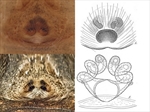Taxonomy
Sandalodes is found in New Guinea and Sulawesi as well as Australia. Australia has five described species, Sandalodes albovittatus, S. bipenicillatus, S. joannae, S, scopifer and S. superbus. The genus is part of an Australasian clade related to Astia (Maddison et al 2008) and is very closely related to the Australian genera Mopsus and Mopsolodes (Maddison 2015). Further information on the genus and described species in Australia can be found in Richardson and Żabka (2023) and Whyte and Anderson (2017).
Description
Sandalodes spp. are medium to large-sized spiders, ranging in body length from 8 to 15 mm. The head, viewed from above, varies from rounded to roughly rectangular with curved sides, widest behind the posterior lateral eyes. The cephalothorax in profile is high and tapers steadily to the rear. Some males have a fringe or crest of dense hairs protruding over the anterior eyes. Chelicerae have a single (unident) retromarginal tooth and two promarginal teeth. The abdomen is elongate-ovate, males narrowing more towards the rear. The legs are long and strongly built with long, strong spines on the tibia and metatarsus. The first pair of legs is longest.
The male’s palp has a short, sharp embolus arising on the distal edge of the tegulum, sometimes extending laterally. The tegulum is almost rectangular in shape without a proximal lobe. The palpal tibia has a single short, sharp, sometimes hollowed-out retro-lateral tibial apophysis, sometimes with notches along the edge.
The female has a single atrium or two poorly-sclerotised atria in the posterior third of the epigyne near the epigastric fold. The copulatory openings are on the lateral or posterior margins of the atria. Highly coiled insemination ducts lead anteriorly to the spermathecae which are somewhat convoluted extensions of the insemination ducts and are located anterior to or overlapping the anterior margin of the atrium. The epigastric fold may have a median notch.
Biology
Sandalodes is found in foliage and on tree-trunks in habitats ranging from rainforest to open woodland. It is also found in and around houses.
Distribution
The genus occurs in all State and Territories including Tasmania. It is not yet known from north-western Australia between the Pilbara and Arnhem Land. Two Australian species, S. scopifer and S. superbus, also occur in New Guinea.
References
Davies, V.T. & Żabka, M. 1989, Illustrated keys to the genera of jumping spiders (Araneae Salticidae) in Australia. Memoirs of the Queensland Museum 27, 189-266.
Richardson, B.J. & Żabka, M. 2023. Salticidae. Arachnida Araneomorphae. Canberra, Australian Faunal Directory. Australian Biological Resources Study, at https//biodiversity.org.au/afd/taxa/SALTICIDAE.
Żabka, M. 2000. Salticidae (Arachnida Araneae) of the Oriental, Australian and Pacific Regions, XIII the genus Sandalodes Keyserling. Invertebrate Taxonomy 14, 695-704
Whyte, R. and Anderson, G. 2017. A field guide to the spiders of Australia. Clayton CSIRO Publishing 451pp.
* The information sheet should be read in the context of the associated diagrams and photographs. Diagrams explaining anatomical terms can be found in the ‘Salticidae’ pictures at the beginning of the list of genera.



